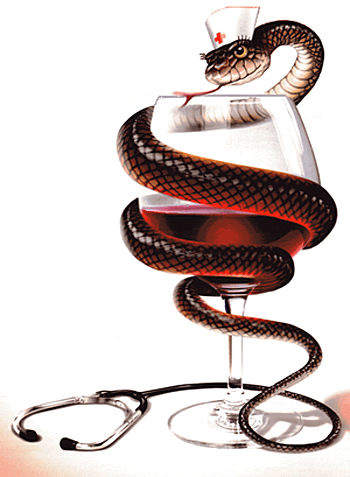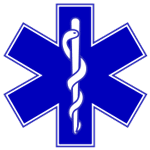Aesculepius, Asculapius (Latin); Asclepius, Asklepios (Greek), Part 2 of 2 +
(A god for all medical doctors)
Another Greek god is incorporated into the Roman hierarchy

The Romans went to the temple at Epidaurus to find help in treating those who where ill with the pestilence that was sweeping Rome in 293 B.C. The cult of Asclepios was introduced to Rome by order of the Sibylline books [sibyl, Greek name: prophetess]. When the delegation went to fetch the image of the god from Epidaurus, they returned with a snake.
The legend of the serpent, in which the god himself was thought to abide (anguem in quo ipsum numen esse constabat), is said to have slipped from the image of the god and followed the Romans through the streets into their ship.
When the ship was at the mouth of the Tiber, the serpent slipped overboard and the temple of the Latin Aesculapiius (asculapius [es" kyoo LAY pee uhs]) came into being on the little island where the serpent went ashore.
What is the significance of the serpent in Greek and Roman medicine?
The serpent is the symbol of Asculapius (Aesculapius) because it represented rejuvenation (renewal) as demonstrated by the periodic shedding of its skin. Many believed that snakes lived forever and that they helped discover health-giving medicinal herbs.
According to one legend, a snake brought such herbs to Asculapius (Aesculapius) and to show his gratitude, he took on the shape of a serpent, too.
The wooden staff was also designated as his symbol, because it represented his wanderings from place to place as he dispensed cures.
It is at this point that disagreements have arisen. Some call the serpent and staff a caduceus and others say it is the "staff of Asclepius", and that they are not the same.


An Associated Press article from about November, 1994, discussed the accuracy of using the caduceus as the symbol for medicine.
According to the article, for about 100 years, doctors, journalists, and book publishers "have been using the wrong symbol for medicine."
It seems that the Minnesota Medical Association wants everyone to know the error of their ways which is, that the caduceus (with two snakes entwined around a staff under a pair of wings) is the staff carried by Hermes, "the Greek god of commerce and merchants" or Mercury, "the Latin god of commerce, merchants, and thieves".
The MMA Journal is quoted as saying the correct symbol for medicine is the one associated with the Greek/Latin god of medicine, Aesclepius (Aesklepius, Greek) or Aesculapius (Latin).
His staff is a single snake wrapped around a crude staff without wings, as shown in the illustration on the left.
Too many people lose their health trying to become wealthy, and then lose their wealth trying to get their health back.
Hermes had many attributes including that of medicine

As the messenger of the Olympian gods, he was an Arcadian fertility god, and god of roads, guardian of travelers, god of communication, and of commerce. He was also credited with dispensing wealth and luck; as a result, he became the god of thieves as a parallel of commerce and thievery when quick riches were noted.
By extension, Hermes was the god of dice; a shepherd's god; and the protector of sacrificial beasts. He also performed another service as the conductor of the souls of the dead to Hades as well as the bringer of dreams, the donor of restful sleep who could also withhold his gift.
In addition, he was the god of eloquence, of social ease, of cunning, fraud, and perjury. In fact, his functions were so varied and numerous that some writers thought that there were several gods with the same name.
Plato claimed that the last words of Socrates before he died from drinking the hemlock, were that he owed a rooster to Asclepius; the traditional sacrifice for a cure, which to Socrates meant death as the supreme "cure" for life.

What we have here is another example of the European concept for the image of an Aesculepius' snake for medical consideration instead of the erroneous Mercurian version of the entwined snakes as used by most American references to some medical situation.
This illustration with the wine glass was used for a discussion of how wine can affect one's health. If drunk in excess, it can be bad; however, if sipped in moderation there usually is no ill effect.
One more example of the "correct symbol" for medicine

![]() Aesculapius, Part 1.
Aesculapius, Part 1.
![]() The caduceus and symbolism.
The caduceus and symbolism.
